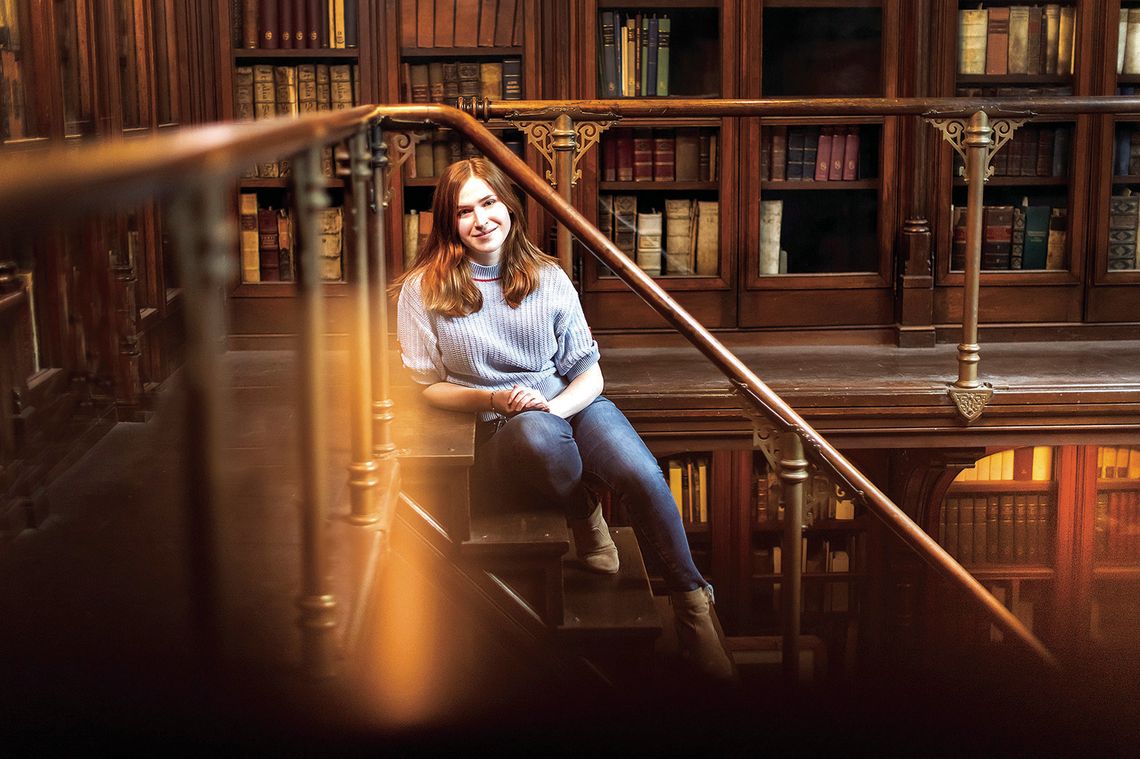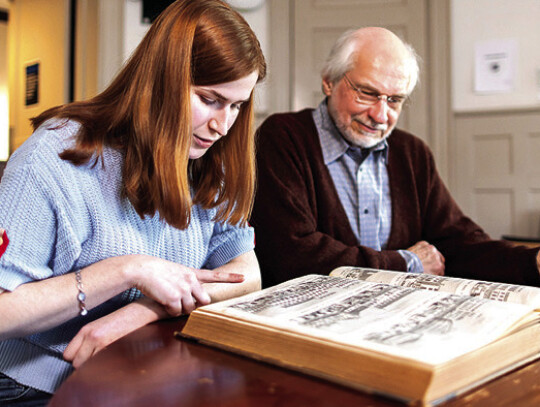Editor’s note: The following article originally appeared in Penn Today, a publication of the University of Pennsylvania.
It had been a long day of closely reading letters written by a painter who lived in the 1800s. Needing a break, University of Pennsylvania history of art major Aili Waller turned her attention to a stack of 19th-century sketchbooks in the museum’s library, choosing the one that didn’t look like the others.
Paging through, she recognized name after name of the obscure artists she had been researching for months, beginning with an assignment in a course on American art. She was looking for one name in particular, Mary Josephine Walters, a painter whose life she had been reconstructing through genealogical sleuthing.
And there, on the last page, says Waller, she saw a detailed painted landscape.
“It was such a crazy moment for me because the second I flipped that page and I looked at it, before I even saw the name, I immediately thought, ‘That’s a Josephine Walters painting,’” says Waller, a third-year student and Lexington resident who was the 2020 valedictorian at Rockbridge County High School. “It’s a previously unknown work by the artist.”
The surprise discovery was shared by her mother, Ann, who joined her on the weeklong research excursion last summer to the New Bedford Whaling Museum in Massachusetts. The two had been researching their family ancestry for years, including many trips to Philadelphia.
“I love genealogy because it’s all biography; it’s all stories, so for me as a kid it was an easier way to envision the past because this was a person’s life,” says Waller. “I loved all those stories. And I just loved all those documents.”
Now Waller is applying those research methods to 19th-century women landscape artists, including deep dives into censuses and city directories and records of births, deaths, marriages, land, wills, probate, and maps and newspapers.
“I realized that all this genealogy research that I started doing as a kid, that’s what original research is,” she says. “And I thought, ‘Yeah, I can do original research. It’s not a scary thing.’ ”
Dedicated To The Discipline
Waller’s journey with Walters started with a routine assignment in her second year at Penn for a course taught by Michael Leja, history of art professor. So “wonderful” was Waller’s paper and so clear was her passion for the research, Leja says, he created an independent study for her last spring.
“She turned up more amazing material every week,” Leja says. “She’s always thinking about the big picture at the same time as she is doing the nitty gritty research with archival data.”
This year her research is being supported as a Wolf Humanities Center Undergraduate Fellow for its Forum on Heritage.
A global medieval and renaissance studies minor, she also is the inaugural outreach intern at the Schoenberg Institute for Manuscript Studies at the Penn Libraries. She hosts events for undergraduates: the astronomical club last semester for books with charts of the skies dating to the 14thcentury and this semester the pre-veterinary club to share medieval texts about animals.
“We thought this was an amazing idea, that just hadn’t occurred to us, to engage with undergraduates in this way,” says Nicholas Herman, the Lawrence J. Schoenberg Curator, adding that Waller is “an amazing self-starter and organizer.” She’s now an integral part of the Institute team, sharing her ideas “about all kinds of things that we do,” says Herman, who taught her in his course on manuscript illumination. “She knows the collection really well.”
André Dombrowski, the Frances Shapiro-Weitzenhoffer Associate Professor of 19th-Century European art at Penn, says Waller’s dual interest in medieval and 19thcentury art sets her apart from most undergraduates, who are more interested in 20thcentury and contemporary art. “She’s unusual in already having this deep historic interest,” Dombrowski says.
A Woman And A Lion Waller recounts having been about 3 years old when she stood in front of a large painting by Henri Rousseau at the Museum of Modern Art in New York City, “The Sleeping Gypsy,” in which a lion approaches a woman lying on the ground.
The artwork was much smaller on the flashcards her mother, a former elementary school teacher, had prepared for the day. “I have a very vivid memory of standing in front of the Rousseau painting with the printout in my hand and just being so terrified of the lion,” Waller says. “I really loved that painting because it was scary. I’ve always loved museums and I love that feeling that art can give you.”
Waller also came along as her mother conducted genealogy research, tracing the family tree to the 1600s. “It turned into this big family history project, and as a kid I loved it,” Waller says. Much of that effort centered on her paternal grandfather’s family from Philadelphia, so several weeks in the summer were spent in the city archives going through books of birth and death certificates and in City Hall reading wills on microfilm.
The family also went to the Penn Museum, and Waller fell in love with it and with the university. “I decided I wanted to go to Penn when I was in third grade,” Waller says. Her brother, Kirk, beat her to it, graduating in 2020.
Focus On Female Artists On campus her second year, having been remote her first year due to the pandemic, she took several art history classes. For a paper assigned in Leja’s course, she thought about an exhibition on 19thcentury women painters in the New York Hudson River School. “There wasn’t a lot about their lives, just that they were artists and some of their works still survive,” Waller says. “I realized that maybe this is a task I wanted to do for my paper and that I could apply my genealogy research.”
She was curious about Walters, who worked with the prominent New York landscape artist Asher Durand. “Part of my project is trying to work around this issue of what do you do when you’re trying to track a person who has no archive,” Waller says. “How are you trying to create this fuller picture of history with people who have been excluded, when the documentation doesn’t seem to be there at first?”
Dombrowski, who has taught Waller in two courses, says her “dedicated and thoughtful and unusual approach to art history research” is on a graduate-student level. “Aili has a knack for wanting to sit there and go through old boxes and excavate old voices, old critics, speaking about 19th-century painting, and landscape in particular, and what they thought and what they saw,” he says.
Leja says Waller possesses a rare combination in an undergraduate researcher: “She is incredibly patient about going through whatever kinds of material she needs to, however long it takes,” together with her “creative imagination, thinking about where she might look based on what she’s finding for more information. She is really good at that.”
Primary Sources In Person During the independent study with Leja last spring she focused on secondary material, like what art historians have said about the period and about the artists in these circles. In the summer Waller was a research associate for Leja and simultaneously continued her own research on Walters.
Waller researched letters by landscape artist Robert Swain Gifford and wrote a magazine article about his correspondence with artist Frances Eliot.
Funded by a Thune Summer Travel Grant from Penn’s History of Art Department, Waller went to the New York Public Library, the Library of Congress in Washington, D.C., and the New Bedford Whaling Museum, to look at primary sources.
In New Bedford she read the archives of 19th-century landscape artist Robert Swain Gifford because she had learned through her research that he was one of about a dozen artists, including Walters, who shared a small studio at 1267 Broadway in Manhattan. Walters was the only woman listed in an etching club Gifford started. “I just kept getting an inkling that they were friends or close colleagues,” Waller says. “Their names kept being next to each other in profiles or in studio notes.”
Waller scoured Gifford’s letters from the 1860s to the 1880s looking for references to Walters. “I did not find her mentioned in the letters,” says Waller, “but I did find a lot of other things. I loved reading through those letters. I was able to get a week-by-week overview of what a New York City landscape artist was doing at that time.”
She also discovered the love story of Gifford and Frances “Fannie” Eliot, also a landscape artist, in their letters to each other. The Whaling Museum asked Waller to write about what she learned for their journal Vistas. “A Marriage Ahead of its Time: Robert Swain Gifford and Frances Eliot” was published in the fall-winter 2022 issue.
Anecdotes in the letters, “especially of Robert supporting Fannie’s career before they were romantically involved,” were her favorites, Waller says. “There were plenty of people who thought women shouldn’t be artists at the time. It’s a kind of reframing in my mind what the 19th century was like for women artists, creating this fuller picture.”
‘Amazing’ Discovery
Among her findings at the Whaling Museum, Waller discovered Fannie Eliot’s artstudent sketchbook. “It was kind of like a scrapbook of the other artists she knew in the city,” Waller says. “She’d glue in one of their pieces, or she’d have them do a drawing.”
Waller found an uncatalogued landscape painting by Mary Josephine Walters in a sketchbook at a Massachusetts museum library.
It was within these pages that Waller found Walters’ painting. “To be able to see a piece that she painted in person, one that was not cataloged, it was just amazing. It was wonderful. It was just so exciting,” she says. “Seeing the painted study in person animated all of the snippets and clippings that I had been collecting for the past year.”
Dombrowski says the discovery is important for several reasons: for the piece itself; for the realization that there are “things like this still out there to be uncovered and recovered” and for the awareness that researchers like Waller in the present are pressing for new inquiries of the past. “It’s not just a discovery of a 19th-century picture. It’s also the rediscovery of a painting by a woman who must have had a terribly difficult time, given the gendered norms of the time, to craft a career as a painter for herself,” he says.
Waller also recovered a thank you note written by Walters to Durand in the microfilm of the Durand papers at the Archives of American Art in Washington, D.C., then tracking it down at the New York Public Library. “That was really exciting getting to see the letter in person and see her handwriting. And this is from 1860, which is the earliest date I had of them crossing paths,” she says.
With her Wolf Humanities fellowship, Waller says she is crafting a narrative from the timeline she is creating of Walters’ life, focused on her career from the 1860s until her death in 1883. The narrative will also be the focus of Waller’s senior thesis next year.
Her work on Walters will likely continue in graduate school as well, as Waller hopes to pursue a master’s and a doctorate in art history, she says, “which is really exciting because I love doing this work.”
.jpg)



